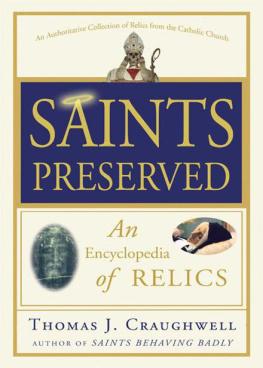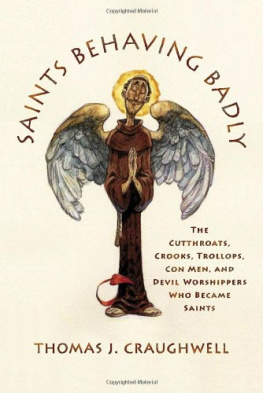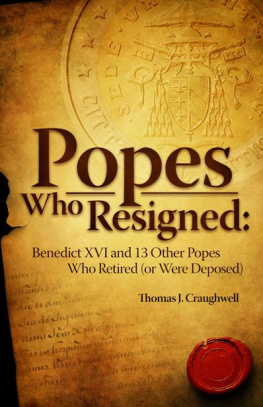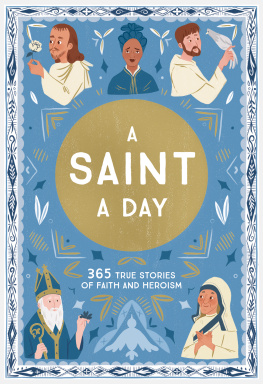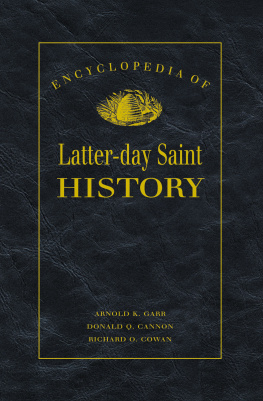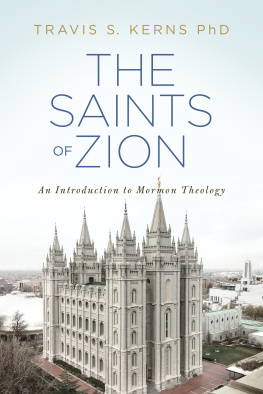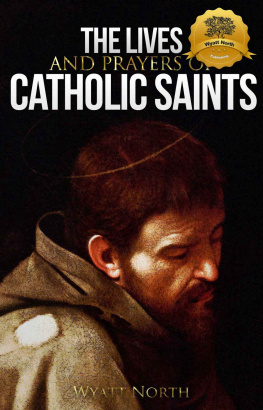Praise for SAINTS PRESERVED

Long before there were cameras and videos to record for posterity, relics had become the visible reminder of great, heroic, and holy livesremembrances of heroes of the faith. Saints Preserved: An Encyclopedia of Relics gives an account of the lives of those heroes and provides renewed inspiration for Christians everywhere who face many of the challenges that were a part of the lives of the saints.
C ARDINAL D ONALD W UERL , coauthor of The Mass and author of The Catholic Way
Relics are an often misunderstood part of the Catholic devotional life. Derided as either superstitious or just plain gross, they are in fact an important reminder of the physicality of the saints. The saints were not mythical creatures or legendary personages, but flesh-and-blood men and women who walked the earth, ate and drank, wore clothes, wrote letters, and lived entirely human lives. Thomas Craughwells new book provides readers with a comprehensive guide to the most important relics in the Church and where they can be found, and venerated. His book is simply one of a kind.
J AMES M ARTIN , S.J., author of My Life with the Saints and The Jesuit Guide to (Almost) Everything
Sacred Scripture tells us that Precious in the eyes of the Lord is the death of His holy ones (Psalms 116:15). These holy men and women, boys and girls, whom we know as saints, are therefore precious to the Catholic Church. Thomas J. Craughwell has rendered an honorable service to the Church and the world with his new book, Saints Preserveda lively and captivating account of three hundred resplendent saints and their holy relics, which we venerate with devotion to this day.
P ATRICK M ADRID , author of Search and Rescue and Does the Bible Really Say That?
Honoring relics was one of the distinguishing marks of early Christianity. A practice rooted in Scripture, it was a universally popular devotion. Thomas Craughwell helps us recover this important element of our tradition. He shares a fascination born of love, the deep familial love that made a family of the firstcentury Church, and can renew our sense of family in the Church of the twenty-first century.
M IKE A QUILINA , author of The Fathers of the Church and Roots of the Faith

Copyright 2011 by Thomas J. Craughwell
All rights reserved
Published in the United States by Image Books, an imprint of
the Crown Publishing Group, a division of Random House, Inc., New York.
www.crownpublishing.com
I MAGE B OOKS and the Image colophon are registered trademarks
of Random House, Inc.
Library of Congress Cataloging-in-Publication
Data Craughwell, Thomas J., 1956
Saints preserved: an encyclopedia of relics/Thomas J. Craughwell.1st pbk. ed.
p. cm.
Includes bibliographical references ().
1. RelicsEncyclopedias. I. Title.
BX2315.C73 2011
235.2dc22 2010050870
eISBN: 978-0-307-59074-9
Cover photography: (top) relics of Saint Geminianus in crypt of
Cathedral of Modena Alinari Archives/Corbis; (left) Saint Suaire exhibition
at the Dome in Turin Alberto Pizzoli/Sygma/Corbis
v3.1
For my friends and fellow relic-hunters
the Carlson Family, the McCaffrey Family,
Msgr. Ignacio Barreiro, and Msgr. Richard Soseman

Contents
Acknowledgments
My first word of thanks goes to my friend and editor, Gary Jansen, the godfather of this book. I am especially grateful to my friend Msgr. Ignacio Barreiro, who has led me through churches and catacombs and monasteries throughout Rome and the surrounding countryside to venerate some of the Catholic Churchs most sacred relics. And my thanks to Ann Gladwin, administrator of the Ladyewell Shrine in England; Father John Fitzpatrick, S.A.C., rector of the Church of San Silvestro in Capite in Rome; Father Alex Kirsten, S.J., director of the Martyrs Shrine in Midland, Ontario; Rev. Knut Andresen of the Nidaros Cathedral, Norway; and Susan Wolff at the National Shrine of St. Odilia in Onamia, Minnesota, all of whom were kind enough to interrupt their day to answer questions from a complete stranger. A special thank-you to Maggie Carr, the gold standard among copyeditors. Finally, my thanks to my friend John Thornton for suggesting the title of this book.
Introduction
Anyone who thinks that the cult of relics of the saints is itself a relic of the Middle Ages should log on to eBay. On any day of the week the online shopper will find a thriving business in the sale of relics, ranging from dust from the tomb of Christ to splinters of the True Cross to bone fragments of countless saints.
Among the faithful, relics have an enormous appeal. In 19992000, when relics of Saint Thrse of Lisieux (18731897), popularly known as the Little Flower, traveled across the United States, millions turned out to touch or kiss the reliquary. The scene was repeated in 2003, when a tiny fragment of the cloak that bears the miraculous image of Our Lady of Guadalupe was carried from parish to parish throughout the country.
Believers will go out of their way to see famous relics. An online search of Catholic travel companies turns up dozens of itineraries designed specifically to visit churches that exhibit renowned relics, such as the incorrupt body of Saint Bernadette in her convents chapel in Nevers, France, and the basilica in Padua, Italy, where Saint Anthony lies buried.
Though many of the most famous relics like Padre Pios gloves and Saint Francis of Assisis tunic are associated with saints, relics are not limited to the Catholic and Orthodox churches. Buddhists venerate the teeth of the Buddha; Islam venerates the sword, the robe, and even strands from the beard of Mohammed. In ancient times, when a farmer or an excavation crew unearthed dinosaur bones, the Greeks and Romans took them for the remains of the Titans, or a legendary hero such as Theseus.
Even secular society prizes relics: at the Abraham Lincoln Presidential Library and Museum in Springfield, Illinois, I saw crowds press around a display case that contained the gloves Mary Todd Lincoln wore to Fords Theatre, stained with the blood of her assassinated husband. No doubt morbid curiosity plays a part, but I believe the desire to see Mary Lincolns bloodstained gloves represents something deeperthe longing to have a physical connection with one of the greatest men, and one of the most tragic moments, in American history. It is that same longing to connect on a physical and not just a spiritual level that draws the faithful to the tombs of the saints, the houses where they lived, the altars before which they prayed, even the prisons where they were tortured.
In the Catholic Church relics fall into one of three categories: a first class relic is the physical remains of a saint, such as bones, hair, and blood; a second class relic is a personal possession of a saint, such as clothing, devotional objects, handwritten letters, even furniture; and a third class relic is an object, such as cloth or a holy card, that is touched to a first class relic.
Reverence for the remains and belongings of saints is rooted in Sacred Scripture. In 2 Kings 13:2021 we read of a dead man being restored to life after his corpse touched the bones of the prophet Elisha. In Marks Gospel we find the story of a woman who suffered from a hemorrhage for twelve years and was cured when she touched the hem of Christs garment (Mark 5:2534). And the Acts of the Apostles recounts how Christians touched handkerchiefs and other cloths to the body of Saint Paul; when these cloths were given to the sick or the possessed, diseases left them and the evil spirits came out of them (Acts 19:1112).

